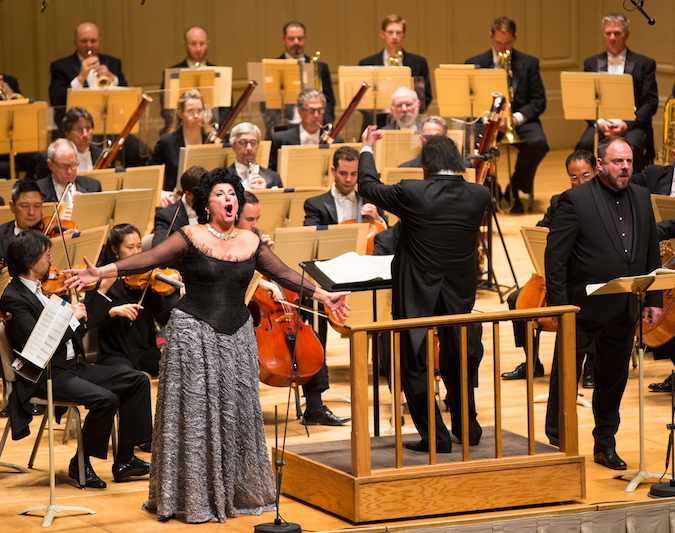Dutoit, BSO open the door to Bartók’s dark “Bluebeard’s Castle”

Soloists Ildikó Komlósi and Matthias Goerne perform Bartok’s “Bluebeard’s Castle” with Charles Dutoit and the Boston Symphony Orchestra Thursday night. Photo: Robert Torres
Judith didn’t know what to expect.
Having left her parents, brothers, and betrothed, the young woman follows Bluebeard, a mysterious Duke, into his dark castle. She is intrigued by what she finds: seven locked doors that, when opened, reveal the secrets of the mysterious man to whom she has entrusted her life.
That is the setting for Bartók’s only opera, Duke Bluebeard’s Castle, which Charles Dutoit, a starry duo of singers, and Boston Symphony Orchestra presented in a rousing concert performance Thursday night at Symphony Hall.
The work is bathed in mystery. More psychological tale than drama, Béla Balázs’ libretto condenses Charles Perrault’s fairy tale into a single act with only two singers, Judith and Bluebeard, unveiling the story. Judith is perpetually curious and asks Bluebeard to unlock each door. Bluebeard initially refuses, but grudgingly allows his new bride to unearth his secrets.
They are dark secrets too. The doors reveal a torture chamber, an armory stocked with weapons, a garden, and a lake of tears. Blood is a constant theme as the walls, weapons, and jewels are covered with ghastly amounts of it.
The story builds to the final reveal. Behind the seventh door are Bluebeard’s former brides, alive, decked with jewels, and preserved for eternity. As Bluebeard crowns Judith with jewels of her own, he exclaims, “You were the most beautiful of them all.”
Concert performances such as that heard Thursday night leave the story’s gory and picturesque details to the imagination. Bartók’s music, a journey from darkness to light and back again, reflects those images to a fine point. A blood motive, a recurring dotted figure heard in the winds, is a constant reminder of Bluebeard’s terrifying mystery.
The vocal parts don’t flow as much as they punctuate stark, direct statements that are closely tied to the rhythms of the Hungarian language. Yet the evening’s singers, both known for their portrayals of this dark work, delivered robust and dramatically rich performances.
As Judith, Ildikó Komlósi sang with a smooth, chocolaty voice that had power and projection in its upper range. The Hungarian mezzo-soprano portrayed the character as eternally devoted to Bluebeard, even as she discovers his deepest secrets. Except for what she finds behind the final door, Judith is curious but never terrified by what she sees. She does grow increasingly contemplative, and the singer softened her tone to match the darkness of her new discoveries.
Bluebeard demands an inky-toned baritone voice, and Matthias Goerne brought haunting mystery to the role. His baritone was full and ripe in its middle register but failed to speak fully in the lowest notes of the part. Goerne, though, had some powerful moments, particularly in the fifth tableaux, which reveals Bluebeard’s expansive domain. There his voice soared in darkly regal phrases over the powerful walls of sound set up by the BSO brass and organ.
Concert versions of Bluebeard’s Castle usually omit the spoken prologue, but Thursday’s performance included it. George Meszoly, inquiring whether the opera’s true stage was inside or outside of the hall, delivered his lines with conviction.
Dutoit led an alert and committed realization of the score. Balances, for the most part, were well proportioned, though some of more robust sections of the opera resulted in the singers being drowned out under waves of orchestral music.
The musicians of the BSO supplied a colorful and picturesque account, with glowing brass chords setting the scene of the treasure room, and horns and strings creating a weird but evocative pastoral for Bluebeard’s garden. The recurring blood motive sounded prickly and fittingly eerie in the strings and winds, and the lake of tears was a picture of mesmerizing beauty. Rarely has a scene of such pain sounded so beautiful.
Mozart’s Symphony No. 39 in E-flat made for a charming and contrasted opener.
Composed in 1788 as the first in Mozart’s final trilogy of symphonies, No. 39 abounds in autumnal lyricism. Dutoit led a careful, if not very adventurous reading that drew out the work’s singing qualities.
That was particularly evident in the second movement, where the conductor sweetened the strings’ phrases with gentle rubato. He also kept the music moving at a chugging pulse, emphasizing the “con moto” of the marked Andante. Even the principal theme of the first movement moved with song-like grace, and the orchestra responded alertly with especially bright playing from the strings.
The Minuet went with rustic vitality, clarinet and flutes echoing each other in silvery melodies in the trio. The finale, taken at a fleet tempo, had a quiet fire, bringing a strong ending to this precision-cut performance.
The program will be repeated 1:30 p.m. Friday and 8 p.m. Saturday at Symphony Hall.bso.org; 888-266-1200
Posted in Performances